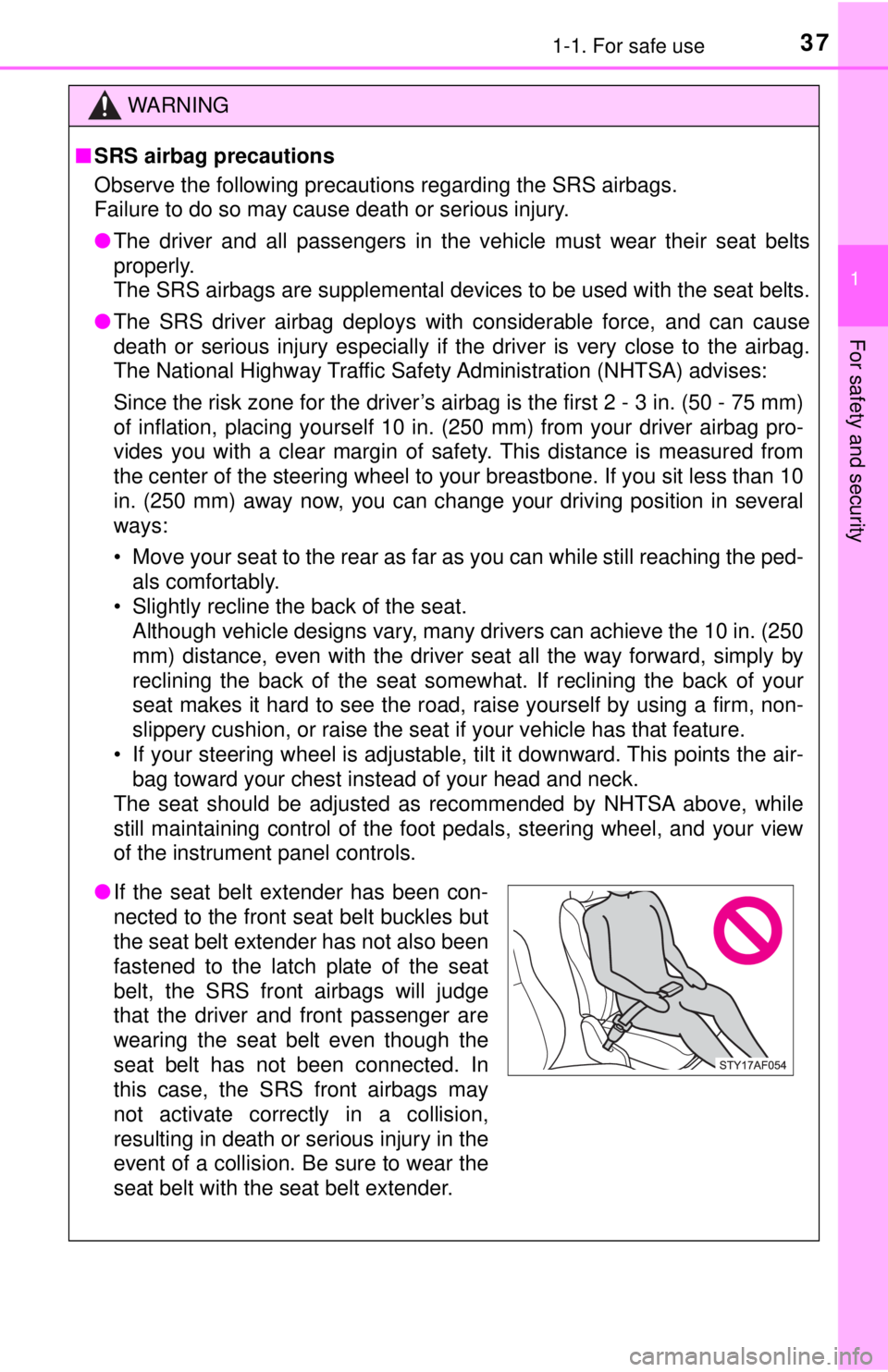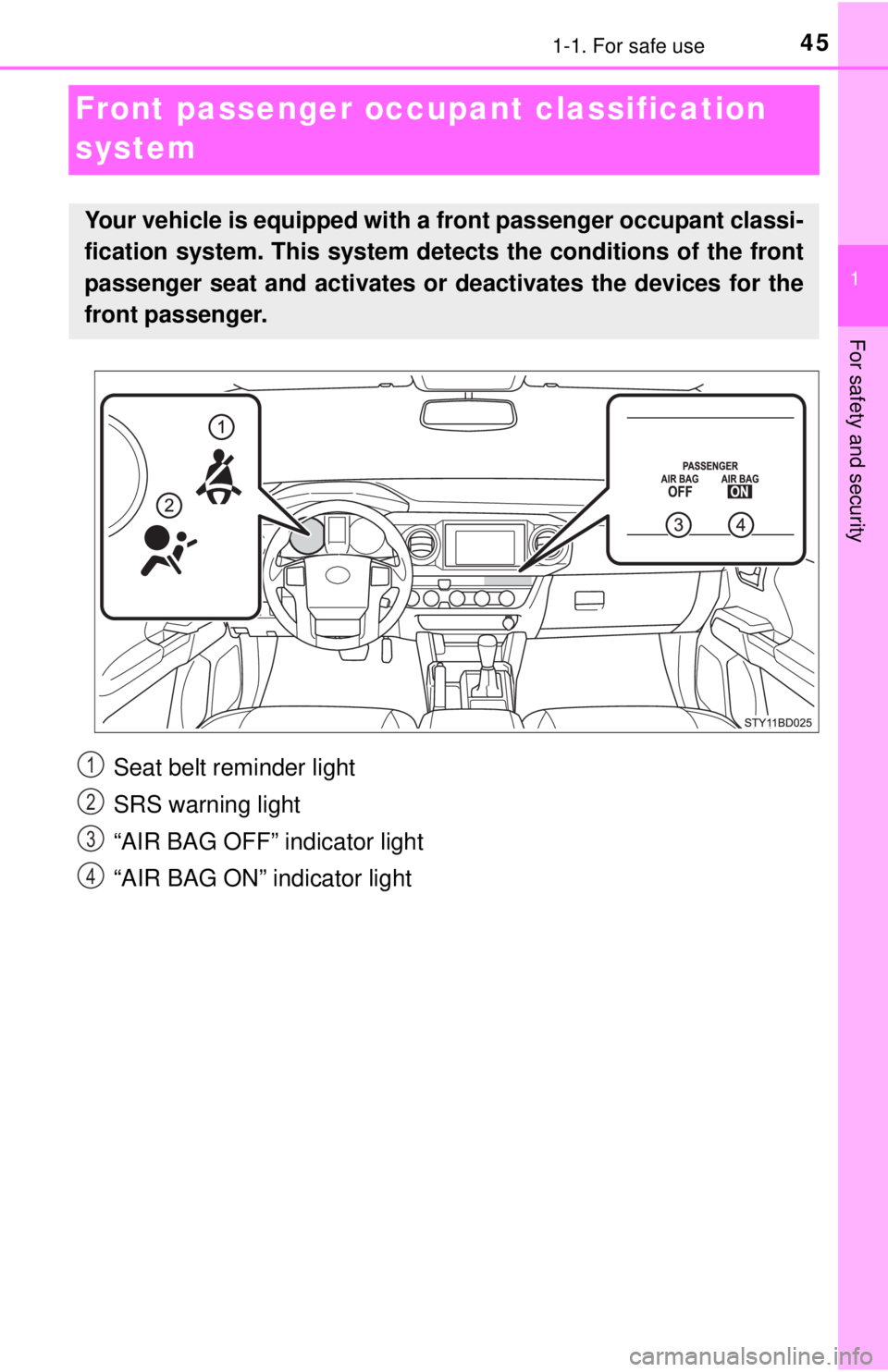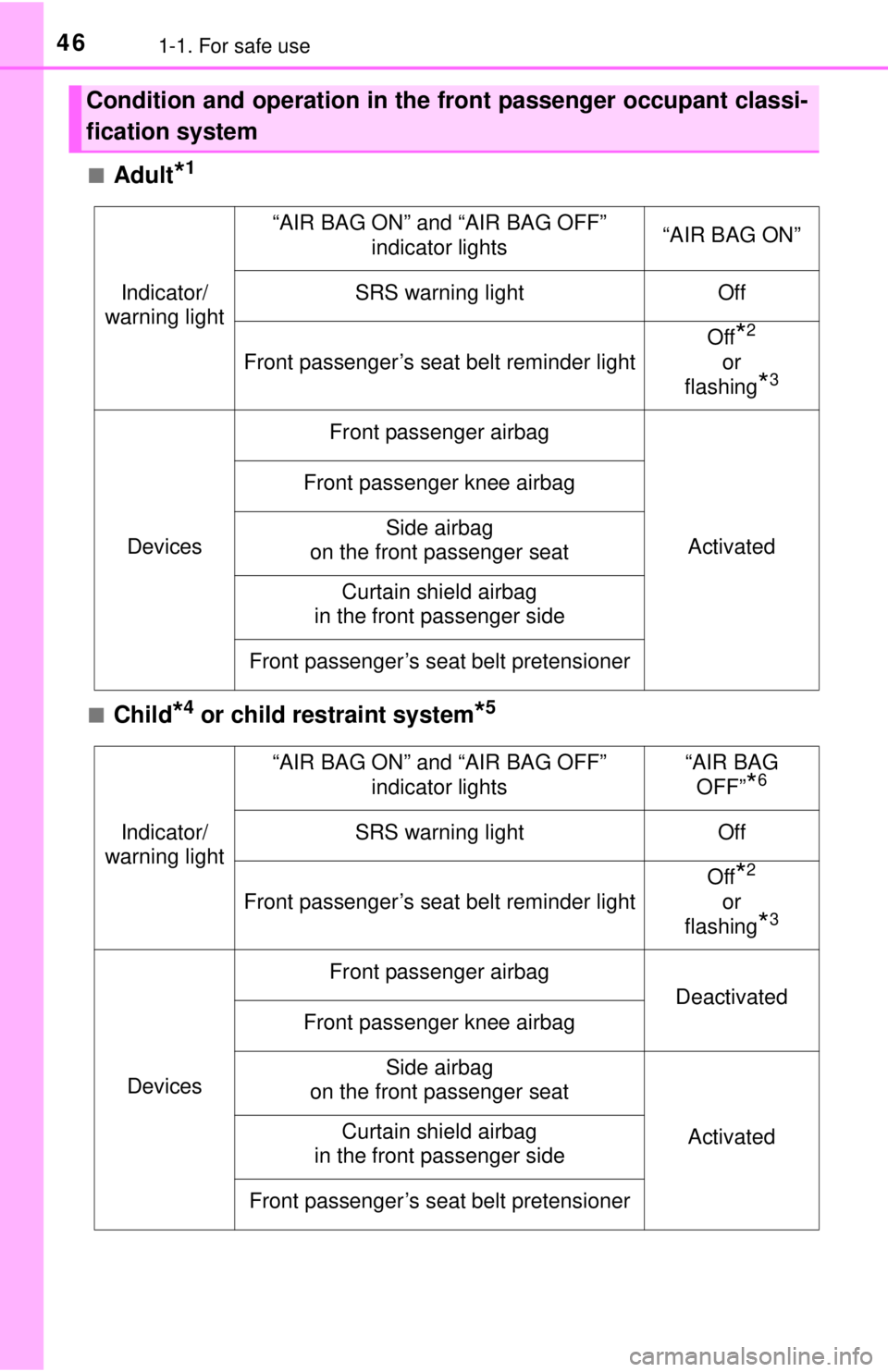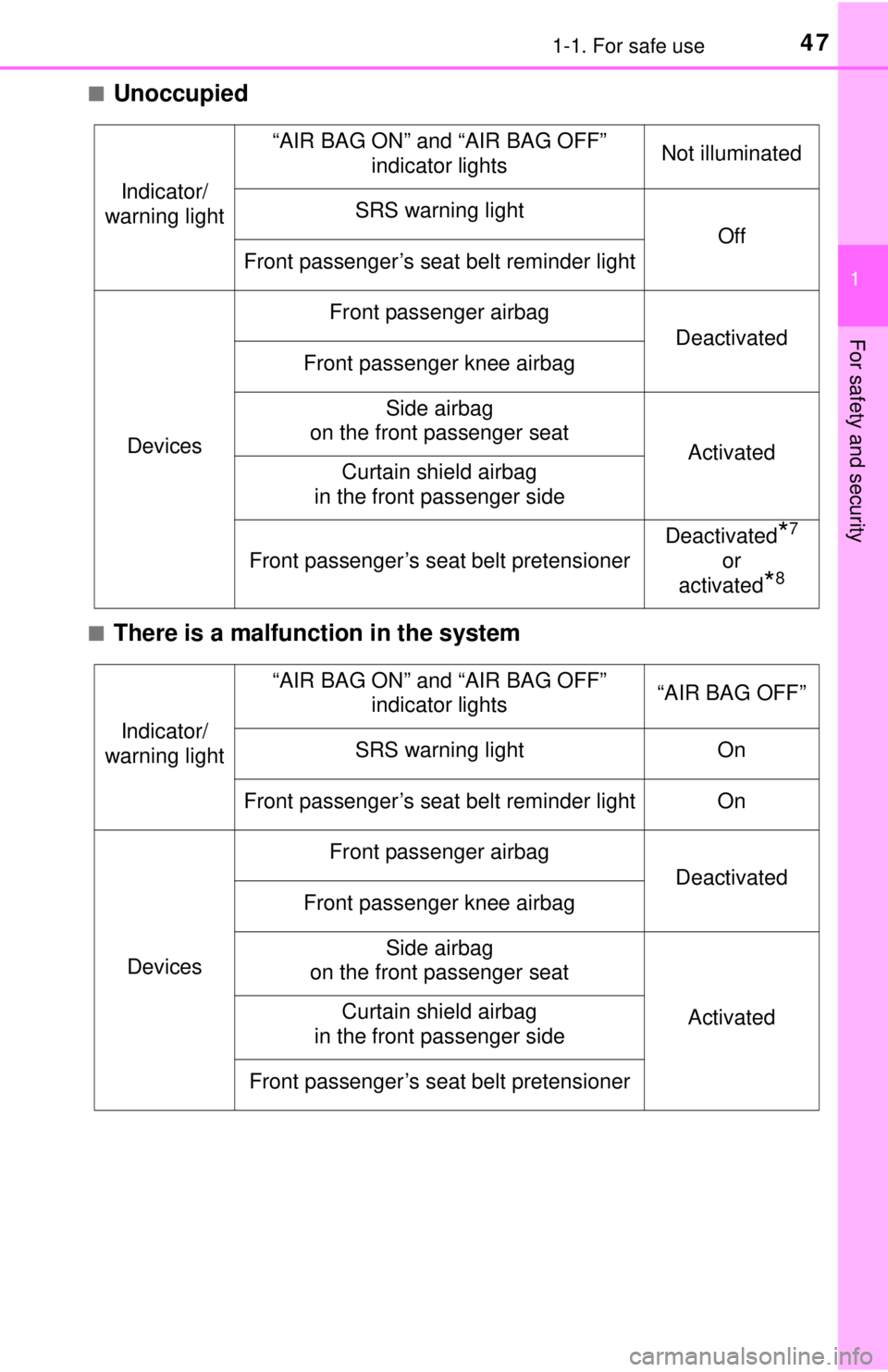2017 TOYOTA TACOMA warning light
[x] Cancel search: warning lightPage 36 of 640

361-1. For safe use
Your vehicle is equipped with ADVANCED AIRBAGS designed based
on the US motor vehicle safety standards (FMVSS208). The airbag
sensor assembly (ECU ) controls airbag deployment based on infor-
mation obtained from the sensors, etc., shown in the system compo-
nents diagram above. This informat ion includes crash severity and
occupant information. As the airbags deploy, a chemical reaction in
the inflators quickly fills the airbag s with non-toxic gas to help restrain
the motion of the occupants.
SRS airbag system components
Seat belt pretensioners
Knee airbags
“AIR BAG ON” and “AIR BAG
OFF” indicator lights
Front passenger airbag
Curtain shield airbags
Side airbags (front seats)
Front passenger occupant
classification system (ECU
and sensors)
SRS warning light Driver airbag
Driver’s seat position sensor
Side impact sensors (rear)
Side impact sensors (front)
Driver’s seat belt buckle
switch
Front passenger’s seat belt
buckle switch
Front impact sensors
Airbag sensor assembly1
2
3
4
5
6
7
8
9
10
11
12
13
14
15
16
Page 37 of 640

371-1. For safe use
1
For safety and security
WARNING
■SRS airbag precautions
Observe the following precautions regarding the SRS airbags.
Failure to do so may cause death or serious injury.
● The driver and all passengers in the vehicle must wear their seat belts
properly.
The SRS airbags are supplemental devices to be used with the seat belts.
● The SRS driver airbag deploys with considerable force, and can cause
death or serious injury especially if the driver is very close to the airbag.
The National Highway Traffic Safety Administration (NHTSA) advises:
Since the risk zone for the driver’s airbag is the first 2 - 3 in. (50 - 75 mm)
of inflation, placing yourself 10 in. (250 mm) from your driver airbag pro-
vides you with a clear margin of safety. This distance is measured from
the center of the steering wheel to your breastbone. If you sit less than 10
in. (250 mm) away now, you can change your driving position in several
ways:
• Move your seat to the rear as far as you can while still reaching the ped- als comfortably.
• Slightly recline the back of the seat. Although vehicle designs vary, many drivers can achieve the 10 in. (250
mm) distance, even with the driver seat all the way forward, simply by
reclining the back of the seat somewhat. If reclining the back of your
seat makes it hard to see the road, raise yourself by using a firm, non-
slippery cushion, or raise the seat if your vehicle has that feature.
• If your steering wheel is adjustable, tilt it downward. This points the air- bag toward your chest instead of your head and neck.
The seat should be adjusted as recommended by NHTSA above, while
still maintaining control of the foot pedals, steering wheel, and your v\
iew
of the instrument panel controls.
● If the seat belt extender has been con-
nected to the front seat belt buckles but
the seat belt extender has not also been
fastened to the latch plate of the seat
belt, the SRS front airbags will judge
that the driver and front passenger are
wearing the seat belt even though the
seat belt has not been connected. In
this case, the SRS front airbags may
not activate correctly in a collision,
resulting in death or serious injury in the
event of a collision. Be sure to wear the
seat belt with the seat belt extender.
Page 45 of 640

451-1. For safe use
1
For safety and security
Front passenger occupant classification
system
Your vehicle is equipped with a front passenger occupant classi-
fication system. This system detects the conditions of the front
passenger seat and activates or deactivates the devices for the
front passenger.
Seat belt reminder light
SRS warning light
“AIR BAG OFF” indicator light
“AIR BAG ON” indicator light1
2
3
4
Page 46 of 640

461-1. For safe use
■Adult*1
■Child*4 or child restraint system*5
Condition and operation in the front passenger occupant classi-
fication system
Indicator/
warning light
“AIR BAG ON” and “AIR BAG OFF” indicator lights“AIR BAG ON”
SRS warning lightOff
Front passenger’s seat belt reminder light
Off*2
or
flashing
*3
Devices
Front passenger airbag
Activated
Front passenger knee airbag
Side airbag
on the front passenger seat
Curtain shield airbag
in the front passenger side
Front passenger’s seat belt pretensioner
Indicator/
warning light
“AIR BAG ON” and “AIR BAG OFF”
indicator lights“AIR BAG OFF”
*6
SRS warning lightOff
Front passenger’s seat belt reminder light
Off*2
or
flashing
*3
Devices
Front passenger airbag
Deactivated
Front passenger knee airbag
Side airbag
on the front passenger seat
ActivatedCurtain shield airbag
in the front passenger side
Front passenger’s seat belt pretensioner
Page 47 of 640

471-1. For safe use
1
For safety and security
■Unoccupied
■There is a malfunction in the system
Indicator/
warning light
“AIR BAG ON” and “AIR BAG OFF”
indicator lightsNot illuminated
SRS warning light
Off
Front passenger’s seat belt reminder light
Devices
Front passenger airbag
Deactivated
Front passenger knee airbag
Side airbag
on the front passenger seat
ActivatedCurtain shield airbag
in the front passenger side
Front passenger’s seat belt pretensioner
Deactivated*7
or
activated
*8
Indicator/
warning light
“AIR BAG ON” and “AIR BAG OFF” indicator lights“AIR BAG OFF”
SRS warning lightOn
Front passenger’s seat belt reminder lightOn
Devices
Front passenger airbag
Deactivated
Front passenger knee airbag
Side airbag
on the front passenger seat
ActivatedCurtain shield airbag
in the front passenger side
Front passenger’s seat belt pretensioner
Page 48 of 640

481-1. For safe use
*1: The system judges a person of adult size as an adult. When a smalleradult sits in the front passenger seat, the system may recognize him/her
as a child depending on his/her physique and posture.
*2: In the event the front passenger is wearing a seat belt.
*3: In the event the front passenger does not wear a seat belt.
*4: When a larger child who has outgrown a child restraint system sits in thefront passenger seat, the system may recognize him/her as an adult
depending on his/her physique or posture.
*5: Never install a rear-facing child restraint system on the front passengerseat. A forward-facing child restraint system should only be installed on
the front passenger seat when it is unavoidable. ( →P. 51)
*6: In case the indicator light is not illuminated, consult this manual on how
to install the child restraint system properly. ( →P. 55)
*7: In the event of a frontal collision or rollover.
*8: In the event of a side collision.
WARNING
■Front passenger occupant classi fication system precautions
Observe the following precautions regarding the front passenger occupant
classification system.
Failure to do so may cause death or serious injury.
● Wear the seat belt properly.
● Make sure the front passenger’s seat belt plate has not been left inserted
into the buckle before someone sits in the front passenger seat.
● Make sure the “AIR BAG OFF” indicator light is not illuminated when using
the seat belt extender for the right front passenger seat. If the “AIR BAG
OFF” indicator light is illuminated, disconnect the extender tongue from
the seat belt buckle, and reconnect the seat belt. Reconnect the seat belt
extender after making sure the “AIR BAG ON” indicator light is illuminated.
If you use the seat belt extender while the “AIR BAG OFF” indicator light is
illuminated, the SRS airbags for the front passenger will not activate,
which could cause death or serious injury in the event of a collision.
● Do not apply a heavy load to the front passenger seat or equipment (e.g.
seatback pockets).
● Vehicles with rear seats: Do not put weight on the front passenger seat by
putting your hands or feet on the front passenger seat seatback from the
rear passenger seat.
● Vehicles with rear seats: Do not let a rear passenger lift the front pass\
en-
ger seat with their feet or press on the seatback with their legs.
● Do not put objects under the front passenger seat.
Page 49 of 640

491-1. For safe use
1
For safety and security
WARNING
■Front passenger occupant classi fication system precautions
● Do not recline the front passenger seatback so far that it touches a rear
seat or a back wall. This may cause the “AIR BAG OFF” indicator light to
be illuminated, which indicates that the SRS airbags for the front passen-
ger will not activate in the event of a severe accident. If the seatback
touches the rear seat or back wall, return the seatback to a position where
it does not touch the rear seat or back wall. Keep the front passenger seat-
back as upright as possible when the vehicle is moving. Reclining the
seatback excessively may lessen the effectiveness of the seat belt sys-
tem.
● If an adult sits in the front passenger seat, the “AIR BAG ON” indicator
light is illuminated. If the “AIR BAG OFF” indicator is illuminated, ask the
passenger to sit up straight, well back in the seat, feet on the floor, and
with the seat belt worn correctly. If the “AIR BAG OFF” indicator still
remains illuminated, either ask the passenger to move to the rear seat, or
if that is not possible, move the front passenger seat fully rearward.
● When it is unavoidable to install a forward-facing child restraint system on
the front passenger seat, install the child restraint system on the front pas-
senger seat in the proper order. ( →P. 55)
● Do not modify or remove the front seats.
● Do not kick the front passenger seat or subject it to severe impact. Other-
wise, the SRS warning light may come on to indicate a malfunction of the
front passenger occupant classification system. In this case, contact your
Toyota dealer immediately.
● Vehicles with rear seats: Child restraint systems installed on the rear seat
should not contact the front seatbacks.
● Do not use a seat accessory, such as a cushion and seat cover, that cov-
ers the seat cushion surface.
● Do not attach a commercial seatback table or other heavy item to the back
of the front passenger seat.
● Do not modify or replace the upholstery of the front seat.
Page 53 of 640

531-1. For safe use
1
For safety and security
WARNING
■Child restraint precautions
● For effective protection in automobile accidents and sudden stops, a child
must be properly restrained, using a seat belt or child restraint system
depending on the age and size of the child. Holding a child in your arms is
not a substitute for a child restraint system. In an accident, the child can be
crushed against the windshield, or between you and the vehicle’s interior.
● Vehicles without rear seats: Toyota strongly urges the use of a proper child
restraint system that conforms to the size of the child.
● Vehicles with rear seats: Toyota strongly urges the use of a proper child
restraint system that conforms to the size of the child, installed on the rear
seat. According to accident statistics, the child is safer when properly
restrained in the rear seat than in the front seat.
● Never install a rear-facing child restraint system on the front passenger
seat even if the “AIR BAG OFF” indicator light is illuminated.
In the event of an accident, the force of the rapid inflation of the front pas-
senger airbag can cause death or serious injury to the child if the rear-fac-
ing child restraint system is installed on the front passenger seat.
● Vehicles without rear seats: A forward-facing child restraint system may be
installed on the front passenger seat only when it is unavoidable. Adjust
the seatback as upright as possible and always move the seat as far back
as possible even if the “AIR BAG OFF” indicator light is illuminat\
ed,
because the front passenger airbag could inflate with considerable speed
and force. Otherwise, the child may be killed or seriously injured.
● Vehicles with rear seats: A forward-facing child restraint system may be
installed on the front passenger seat only when it is unavoidable. A child
restraint system that requires a top tether strap should not be used in the
front passenger seat since there is no top tether strap anchor for the front
passenger seat. Adjust the seatback as upright as possible and always
move the seat as far back as possible even if the “AIR BAG OFF” indicator
light is illuminated, because the front passenger airbag could inflate with
considerable speed and force. Otherwise, the child may be killed or seri-
ously injured.